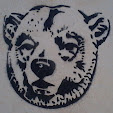It sometimes seems to me that the 'Internet Generation' can't get their heads round the difference between them, even Wikipedia (and I've several links to them - bottom of left column) get all confusing trying to explain it!
If something is 20mm high, that is its 'size'...it is - in other words - 2cm tall. If it is 4mm 'scale' then it is representing something in real life at a 'ratio' of 4mm to one foot, making a 20mm figure representative of a 5' high real person, but if the figure is described as HO, it simply means it is designed to go with model railway stock running on rails that are a specific distance apart.
The details of which I'll save for another day as I was only casting around for a hook to hang tonight's post on and I intend to come back to figure sizes again!!
 So what was worth all that...This lovely little set here, all nestled in bright-green wood-shavings.
So what was worth all that...This lovely little set here, all nestled in bright-green wood-shavings.I believe these are by Berger a company that operated from Thuringen in the former East Germany, and who produced these sometime in the 1960's. The reason I think they are Berger is down to the little details that set all manufacturers apart.
In this case the similarities are;
*Small wire-hole (?) in the base
*Short legs
*Dumpy bodies
*Heavy bases with a cone-like profile
*Plaster-like compound/composition material
*Around the 2.8cm stated as being right for these figures in Reinhard Schiffmann's Sammlerkatalog - Band 12 (collectors catalogue - part 12)
*Colouring - particularly the pinks
*The way the faces have been painted
When trying to give a name to an unknown set you must always admit the minuses as well;
*No patterned paper lining on the lid of the box
*Bases are green not grey
While they - at 28mm - would be rejected by today's hyper-real purists as being too big, the 'size' includes the heavy base necessary to keep weighty figures upright, and the tin-plate trains they were aiming at lacked accuracy themselves, nevertheless they were the HO range. And err...they were TOYS!



No comments:
Post a Comment